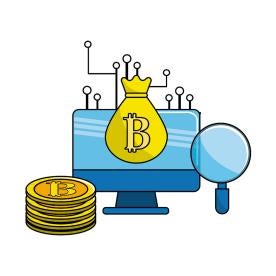On March 9, 2022, President Biden issued an Executive Order on Ensuring Responsible Development of Digital Assets (the “Executive Order”) that sets in motion a “whole-of-government” strategy to address the impacts of the rise of digital assets—including cryptocurrencies—on consumers, the economy, national security, and climate change.1 In so doing, the Executive Order reiterated that “digital mines” create tangible climate risk.
In this climate change update, we examine (1) the potential climate risks caused by the proliferation of digital assets, (2) the Executive Order’s directives concerning the interplay between digital assets and climate change, and (3) current initiatives to be evaluated under the Executive Order.
Background: Cryptocurrency and Climate Risk
Cryptocurrency “is a medium of exchange that is digital, encrypted and decentralized.”2 Cryptocurrency utilizes consensus mechanisms to validate transactions, which allows for legitimate mining of and transactions using blockchain tokens. There are two major types of consensus mechanisms—proof of work and proof of stake—that are employed to achieve the security and trust at the heart of the decentralized networks on which digital assets are traded. Proof of work is the consensus mechanism in which miners solve complex puzzles and difficult math problems to add new blocks to the chain and earn a crypto reward.3 By contrast, proof of stake functions as a lottery in which miners become “validators”. In the case of the Ethereum 2.0 blockchain, for instance, this is achieved by putting up 32 ether (Ethereum’s cryptocurrency) to be in the pool of potential validators. The winning validator is then “randomly chosen by an algorithm” and awarded ether after its block is accepted by a group of other validators also selected by the algorithm.4
The rising price of cryptocurrencies has caused the current proof of work system to set ever rising levels of difficulty to ensure that only one new block is mined every ten minutes. Thus, the more miners (or the greater connected computing power), the more difficult the solution must be to ensure consistent intervals between the addition of each block. The rising price of cryptocurrencies incentivizes miners to consume more energy through the use of more powerful machines, to run more machines or to join mining pools where miners cooperate to mine blocks and distribute earnings on a pro rata basis. The increasingly powerful computers are constantly running, using significant amounts of electricity to achieve the required processing output to solve the more complex challenges. In this way “[t]he most widely used implementations of the [cryptocurrency and blockchain-based] technolog[ies] consume large and growing amounts of energy, which is associated with growing greenhouse gas (GHG) emissions.”5
Executive Order Overview
In keeping with a priority of the current administration to focus on climate change mitigation, the Executive Order seeks to better understand and mitigate environmental risks for activities relating to digital assets.6 To that end, the Executive Order proclaims that the United States will promote and support the crypto ecosystem by advancing the responsible development, financial management and use of digital assets in such a manner as to “reduce negative climate impacts and environmental pollution, as may result from some cryptocurrency mining.”7 Specifically, the Executive Order calls for the implementation, and compliance monitoring, of climate impact standards for digital assets. For example, the Executive Order’s call for “responsible financial innovation” is coupled with the Administration’s commitment to “take strong steps to reduce the risks that digital assets could pose to consumers, investors, and business protections; financial stability and financial system integrity; combating and preventing crime and illicit finance; national security; the ability to exercise human rights; financial inclusion and equity; and climate change and pollution.”8 Technological leadership is required in this rapidly growing space, and the Executive Order spotlights the Administration’s twin aims of supporting innovation while mitigating the risks for consumers, businesses, the broader financial system, and the climate.9
The Executive Order also instructs the Director of the Office of Science and Technology Policy (OSTP), in consultation with the Secretary of the Treasury, the Secretary of Energy, the Administrator of the Environmental Protection Agency, the Chair of the Council of Economic Advisers, the Assistant to the President and National Climate Advisor, and the heads of other relevant agencies, to prepare a report (the “Report”) to be delivered to the President within 180 days and updated within one year of submission.
Through the Report, the Executive Order mandates the Director of OSTP to assess “the connections between distributed ledger technology and short-, medium-, and long-term economic and energy transitions; the potential for these technologies to impede or advance efforts to tackle climate change at home and abroad; and the impacts these technologies have on the environment.”10 This includes attention to the effect of cryptocurrencies’ consensus mechanisms on energy usage, including research into potential mitigating measures and alternative mechanisms of consensus and the design tradeoffs those may entail.
The Report should specifically address “(A) potential uses of blockchain that could support monitoring or mitigating technologies to climate impacts, such as exchanging of liabilities for greenhouse gas emissions, water, and other natural or environmental assets; and (B) implications for energy policy, including as it relates to grid management and reliability, energy efficiency incentives and standards, and sources of energy supply.”11
The Report May Assess Current Mitigation Efforts
Over the coming months, the Director of OSTP is expected to review current initiatives and critically evaluate whether they might successfully mitigate the negative climate impacts claimed by some to be consequences of the proliferation of digital assets. The Report may also provide new and alternative approaches to reduce climate risk.
As is often the case with climate change regulation, the United States may look to Europe, which has consistently taken the lead in this area.12 This week, the European Union Parliament’s Economic and Monetary Affairs Committee voted to approve revisions to the Markets in Crypto Assets (“MiCA”) report, which establishes the EU’s “negotiating position on new rules on crypto-assets,” as well as a legal framework regulating public offerings for these assets.13 Significantly, this revision to the MiCA report removed language that sought to limit the use of cryptocurrencies that rely on the energy-intensive proof of work consensus mechanism by forcing a switch to proof of stake.14 Instead, the approved MiCA report tasks the European Commission with drafting “a legislative proposal to include in the EU taxonomy for sustainable activities any crypto-asset mining activities that contribute substantially to climate change.”15 This proposal is due January 1, 2025.
An example of a current climate-related crypto industry initiative which the Report may address is the Crypto Climate Accord (“CCA”). CCA was co-founded by nonprofits Energy Web, Rocky Mountain Institute (RMI) and the Alliance for Innovative Regulation (AIR) and a cohort of initial companies. To date, over 250 companies have signed CCA’s Accord. The stated objective is to support “the entire crypto industry’s transition to net-zero greenhouse gas emissions by 2040.”16 The Accord has two specific interim objectives: (1) achieve net-zero emissions from electricity consumption by 2030 and (2) develop standards, tools, and technologies with Crypto Climate Accord supporters to accelerate the adoption of and verify progress toward 100% renewably-powered blockchains by the 2025 United Nations Framework Convention on Climate Change (“UNFCCC”) COP30 conference.17
CCA has outlined six strategies and tools for reducing emissions from digital mining. These include (1) reducing the total amount of electricity used through optimizing existing infrastructure or sourcing more efficient hardware; (2) altering the timing of electricity use to off-peak times when energy generation on the grid may produce lower emissions; (3) changing the location of mining operations to draw energy from a different grid; (4) investing in on-site clean electricity generation; (5) procure unbundled energy attribute certificates (EACs) equal to the number of megawatt-hours of electricity used for mining; and (6) contracting for renewable energy offsite through either direct or virtual power purchase agreements.18
Another approach, similar to the procurement of EACs, is to purchase carbon offsets tied to cryptocurrency. There are several initiatives, some using crypto technology, which offer a potential fix to previous concerns that offsets were not uniformly priced and not clearly linked to climate-beneficial, carbon-removal activities.19 One initiative in particular, a nonprofit, decentralized finance project called Toucan, allows owners of carbon credits to link them to digital tokens.20 The theory behind linking credits to tokens is the establishment of “clearer pricing and ownership data,” which in turn tracks the owners who fund climate-benefiting projects.21 It is unclear whether such initiatives will gain traction in crypto markets, however, and the purchase of offsets is dependent upon crypto traders, not the digital asset-based companies themselves.
In addition, the Report may address proof of stake protocols as they impact climate initiatives. At least one blockchain, Ethereum, is taking steps to convert to a new mining architecture. Rather than the carbon-intensive proof of work system used in Ethereum 1.0, in which miners use high-powered computers to continuously compete to solve puzzles, the ether cryptocurrency of Ethereum 2.0 may be mined using a proof of stake method as early as this year.22 In the proof of stake system, miners will “put forward their holdings as a down payment” which then enables them to mine new coins.23 Once proof of stake replaces proof of work “the only electricity cost will come from the servers that host Ethereum nodes [i.e., the computers running the cryptocurrency software, validating transactions and blocks], similar to any company that uses cloud-based computing.”24
Conclusion
Though efforts are underway to address climate risks posed by digital mining, the Executive Order’s mandate to examine and report may further these efforts and advance climate-focused initiatives and policy in the digital asset space. It is difficult to predict how far the Report will go, although in light of the whole-of-government approach, the proposals therein potentially could be broad and wide-ranging. However, as the United States is determined to take a lead in crypto-climate initiatives, even as other countries and regions delay the transition away from energy-inefficient digital mining such as proof of work, the Report will likely emphasize and encourage blockchain applications that optimize and support clean energy initiatives like those described herein. Regardless of the final Report, both entities in the digital asset and blockchain ecosystem and investors looking to add digital assets to their portfolios should keep apprised of how the Report and subsequent policymaking may impact their products or future investments.
FOOTNOTES
1 The White House, FACT SHEET: President Biden to Sign Executive Order on Ensuring Responsible Development of Digital Assets (Mar. 9, 2022), https://www.whitehouse.gov/briefing-room/statements-releases/2022/03/09/fact-sheet-president-biden-to-sign-executive-order-on-ensuring-responsible-innovation-in-digital-assets/.
2 Kate Ashford & John Schmidt, What is Cryptocurrency?, Forbes (Updated Jan. 25, 2022), https://www.forbes.com/advisor/investing/what-is-cryptocurrency/.
3 Amy Castor, Why Ethereum is switching to proof of stake and how it will work, MIT Tech. Rev. (Mar. 4, 2022), https://www.technologyreview.com/2022/03/04/1046636/ethereum-blockchain-proof-of-stake.
4 Id.
5 Marc Johnson & Sahithi Pingali, Guidance for Accounting and Reporting Electricity Use and Carbon Emissions From Cryptocurrency, Crypto Climate Accord (Dec. 15, 2021), https://cryptoclimate.org/wp-content/uploads/2021/12/RMI-CIP-CCA-Guidance-Documentation-Dec15.pdf.
6 Executive Order on Ensuring Responsible Development of Digital Assets (Mar. 9, 2022), https://www.whitehouse.gov/briefing-room/presidential-actions/2022/03/09/executive-order-on-ensuring-responsible-development-of-digital-assets/.
7 Id. at § 2(f).
8 Id. at § 1.
9 The White House, FACT SHEET: President Biden to Sign Executive Order on Ensuring Responsible Development of Digital Assets (Mar. 9, 2022), https://www.whitehouse.gov/briefing-room/statements-releases/2022/03/09/fact-sheet-president-biden-to-sign-executive-order-on-ensuring-responsible-innovation-in-digital-assets/.
10 Executive Order, § 5(b)(vi).
11 Id.
12 Jason Halper, et al., Investors and Regulators Turning up the Heat on Climate-Change Disclosures, Harv. L. Sch. F. On Corp. Governance (July 24, 2021), https://corpgov.law.harvard.edu/2021/10/04/investors-and-regulators-turning-up-the-heat-on-climate-change-disclosures/.
13 European Parliament, Press Release, Cryptocurrencies in the EU: new rules to boost benefits and curb threats (Mar. 14, 2022), https://www.europarl.europa.eu/news/en/press-room/20220309IPR25162/cryptocurrencies-in-the-eu-new-rules-to-boost-benefits-and-curb-threats.
14 Sandali Handagama, EU’s Sweeping Crypto Regulations Package One Step Closer to Ratification, CoinDesk (March 14, 2022), https://www.coindesk.com/policy/2022/03/14/eus-sweeping-crypto-regulations-package-one-step-closer-to-ratification/.
15 European Parliament, Press Release, Cryptocurrencies in the EU: new rules to boost benefits and curb threats (Mar. 14, 2022), https://www.europarl.europa.eu/news/en/press-room/20220309IPR25162/cryptocurrencies-in-the-eu-new-rules-to-boost-benefits-and-curb-threats.
16 Crypto Climate Accord (last visited Mar. 12, 2022), https://cryptoclimate.org/accord/.
17 Id.
18 Marc Johnson & Sahithi Pingali, Guidance for Accounting and Reporting Electricity Use and Carbon Emissions From Cryptocurrency, Crypto Climate Accord (Dec. 15, 2021), https://cryptoclimate.org/wp-content/uploads/2021/12/RMI-CIP-CCA-Guidance-Documentation-Dec15.pdf.
19 Dieter Holger, Cryptocurrency Traders Move Into Carbon Markets, Wall St. J. (Jan. 10, 2022), https://www.wsj.com/articles/cryptocurrency-traders-move-into-carbon-markets-11641826402?mod=newsviewer_click#:~:text=Cryptocurrency%20technology%20is%20making%20a,tokens%20and%20removed%20from%20circulation.
20 Id.
21 Id.
22 Adam Morgan McCarthy, Ethereum's ETH 2.0 shift to proof-of-stake is just months from launch, and analysts are bullish about the update. Here's why., Business Insider (Mar. 6, 2022), https://markets.businessinsider.com/news/currencies/ethereum-blockchain-technology-crypto-cryptocurrency-ether-eth-vitalik-buterin-markets-2022-3.
23 Id.
24 Matthew Leising, Ethereum Closes In on Long-Sought Fix to Cut Energy Use Over 99%, Bloomberg (May 23, 2021), https://www.bloomberg.com/news/articles/2021-05-23/ethereum-closes-in-on-long-sought-fix-to-cut-energy-use-over-99.








 />i
/>i

